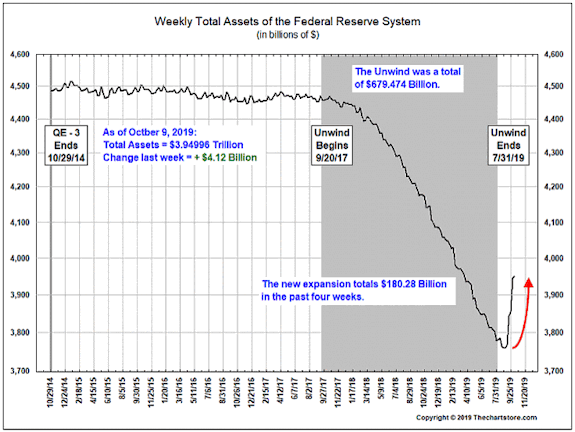|
Dear Fellow Investor,
I’d been warning that this would happen for a few years.
First, I told investors that once the Fed decided to start cutting rates again, gold would quickly add a couple hundred dollars to the price.
So far, the metal’s risen about $250 since the Fed hinted at its first rate cut.
But the big move, I said, would come when the central bank decided to restart quantitative easing.
Exactly one week ago Fed Chairman Jerome Powell seemed to do just that, announcing a new program to buy $60 billion of Treasury bills each month through the end of the second quarter of 2020.
But, he stressed, don’t you dare call this QE.
This new program “should in no way be confused with the large-scale asset purchase programs that we deployed after the financial crisis,” cautioned Powell. To go further, he subsequently stressed that “in no sense is this QE.”
“What has been will be again,
what has been done will be done again;
there is nothing new under the sun.”
Ecclesiastes 1:9
OK, whatever you say Chairman.
Over the past few decades of watching the markets and the political circus on a daily basis, and talking with some of the world’s leading experts and players in geopolitics, I’ve learned a few things.
One of them is not to take public pronouncements like this at face value. In fact, the truth is almost always precisely the opposite of what the political hacks are trying to make you believe.
So if they don’t want you to think this is QE, if they’re going to such great pains to say it isn’t, then it is almost assuredly precisely that.
“A rose by any other name would smell as sweet.”
So why would Chairman Powell want us to think that this isn’t the start of the next round of unconventional monetary policy? The reasons are obvious, and include:
• A return to QE would expose the Fed’s failure to normalize monetary policy.
• It would spotlight the fact that the previous rounds of QE didn’t work.
• It would indicate that the Fed regards the current economic situation as desperate enough to renew QE — even though it didn’t work the first time.
• It would seem that the Fed was kowtowing to pressure from President Trump.
There are other reasons, but these will suffice. So if they’re lying to us, or in the more-polite parlance, being “disingenuous,” then what’s really going on?

“If it duck and quacks like a duck, then...”
Wikipedia defines quantitative easing as “a monetary policy whereby a central bank buys predetermined amounts of government bonds or other financial assets in order to inject liquidity directly into the economy.”
In this case, it seems obvious to all but the most deluded Fed water-carriers (watch CNBC for case studies) that this new program fits the definition of QE like a fine Italian suit.
You can call it whatever you want, but it is what it is. And it is QE.
Consider that when the Fed announced QE1 on November 25, 2008, the stated goal of this limited program was to purchase about $700 billion in securities over “several quarters.”
If we define several quarters as nine months, that $700 billion works out to about $66 billion per month — remarkably close to the $60 billion the Fed just announced.
Add in the $60-$100 billion in revolving short-term repo funding operations...
...Plus the $180 billion they’ve already added to the balance sheet over the last month (see the accompanying chart by Ron Griess of TheChartStore.com)...
...And this new “temporary” program that-you-should-never-call-QE is already larger than the initial version of QE1 in 2008.

What’s Next?
The Fed is assuring us that this isn’t the beginning of a return to the extraordinary, previously unprecedented policies of quantitative easing.
At this point I think it’s important to note that this is precisely what former Fed Chairman Ben Bernanke assured us on January 13, 2009, in an official speech entitled “The Crisis and the Policy Response.”
As Bernanke assured us back then, “The Federal Reserve’s approach to supporting credit markets is conceptually distinct from quantitative easing (QE), the policy approach used by the Bank of Japan from 2001 to 2006.”
Of course, we know what happened next. By the end of 2014, the Fed’s balance sheet had added nearly $4 trillion in assets.
Make no mistake, we would be foolish not to be prepared for a repeat performance.
Strike that — this won’t be a repeat; every bit of evidence argues that it will be an escalation of the previous policies. And by a considerable margin.
As you can see from our chart, it’s already begun.
To see how far it will go, consider how modern economies, built upon foundations of central bank proffered monetary adrenaline, are like addicts in need of ever-greater doses to get the same result.
In fact, there is never enough to satisfy the craving, and the financial markets (which are now inseparable from their associated economies) need ever-lower interest rates and ever-more monetary liquidity.
So what are the implications? How should we prepare?
The most obvious answer is to make sure we have plenty of gold. If the last rounds of QE brought gold to a new nominal high of $1,920, these new rounds should take it past the old 1980 high in real, current-dollar terms.
And that means a gold price in excess of $2,800, or about 85% above the current levels.
How To Find
Protection And Profits...
A lot of very smart people, many of whom I call friends, are predicting precisely how the central banks’ next rescue operations will affect the dollar, currencies, the stock market, bonds and everything else.
Some have described the path ahead in great, frightening detail.
Frankly, I’m not smart enough to predict exactly what’s going to happen as the Fed inevitably expands this first step back into QE. And I don’t think anyone else can tell you either.
But I do know this with great confidence: You want to own gold (and silver) going into this next phase.
Moreover, this new bull market in gold and silver promises to be a major, multi-year trend that will take the shares of junior mining stocks to dizzying heights.
It’s already beginning, as many of our Gold Newsletter picks have multiplied in price. Others are poised to do so.
Once again, this is the kind of opportunity that only comes every 10 or 15 years...one where we’re in a confirmed gold and silver bull market, and yet junior mining shares are still near bargain-basement levels.
You can find the best of these opportunities — the top picks of today’s top experts on the junior resource sector — at the upcoming New Orleans Investment Conference, being held in a couple of weeks, from November 1-4.
There’s still time for you to reserve your place at this blockbuster event.
But please heed this warning: Our room block at the luxurious Hilton Riverside is about to close.
Outside of this convenient room block, rooms in New Orleans at this time of year are incredibly expensive and hard to find. A couple of years ago the entire city sold out!
So if you hope to attend this year’s New Orleans Conference and take advantage of this generational opportunity, CLICK HERE to learn more and secure your spot. (As an added bonus, you’ll save $400 if you can act now.)
All the best,

Brien Lundin
Editor, Gold Newsletter
CEO, the New Orleans Investment Conference
|